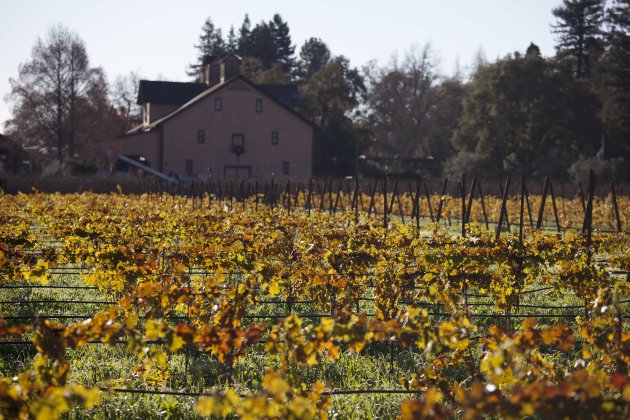
Napa Valley, one of the world's premier wine growing regions, has an uncommon problem these days: not enough new grapevine root stock is available to supply the massive replanting that's under way there. A trifecta of developments has created the critical shortage:
Aging cabernet vines planted after a deadly phylloxera outbreak in the 1980s are due for replacement that was deferred for years as sales of premium wines slumped in the recession.
With demand again strong, growers
are taking the opportunity to replace old vines with varieties and
clones better suited for their microclimates. Others are reconfiguring
rows to prevent erosion into sensitive streams, or to allow mechanical
harvesting machinery to access vines.
All of this activity caught commercial nurseries across California
short of supply. Some are sold out for 2013 and are taking orders for
2014 and beyond."I've never seen anything like this," said Michael Monette of Sunridge Nurseries, one of the industry's biggest suppliers of plants. "What's totally phenomenal for me is I'm focusing on 2014 and 2015, which is absolutely nutso. We have no more space in our greenhouses."
Napa Valley, an hour's drive northeast of San Francisco, caught the world's attention in 1976 when, to the shock and chagrin of the French, wines from Stag's Leap and Chateau Montelena won the Paris Wine Tasting. The ensuing rush to plant was cut short when the rootstock that most new growers used was not fully resistant to the root-eating phylloxera pest.
Nearly two-thirds of the vines
there slowly died, and vineyard owners yanked millions of plants
beginning around 1990 then spent $1.2 billion replacing them.
That replanting of new clones on more resistant rootstock are the
vines on which the Napa Valley's current reputation for excellence was
sealed. Today wines from Napa Valley's 16 sub-appellations are some of
the most complex and priciest produced.
After 20 years, however, plants reach old age and yields begin to diminish in a region where a ton of grapes can fetch $4,500 or more.
Growers routinely replace plants,
but the convergence of events has created an urgency that prompted the
Napa Valley Grapegrowers to gather experts last week to talk about
planning, plant financing and even preventing erosion during the process
in a region of sensitive habitat.
"The defining feature of this movement is the scale at which it is
taking place," said Jennifer Putnam, executive director of the
association. "That nurseries are sold out is unprecedented. That an
industry is reinvesting in itself right now is a sure sign we're coming
out of the recession."Mondavi alone is in the process of planting 1.5 million new vines, she said. One vineyard management company alone removed 8,000 acres this year.
"A lot has changed since the phylloxera replanting," said Putnam. "We've learned more about the soil, and what varieties might be better suited for a site, maybe the row orientation should change. We're at the beginning of a wave of change."
While grapes can grow by simply
planting a cane in the ground, those plants will not be resistant to
pests and disease. Nurseries graft European vines onto native North
American grape plant roots, which are naturally resistant to phylloxera.
Botanists further tweak rootstocks to resist local pests and disease,
or to control the vigor of the vines.
"It has been 23 years since 1990,
so that's a lot of acreage coming due," said Jon Ruel, chief operating
officer at the 480-acre Trefethen Family Vineyard in Napa Valley's Oak
Knoll District. "Growers were quiet for a number of years, but now we
have a lot more optimism. Now wineries want grapes and growers are like,
'Shoot, I should have planted a few years ago.'"
Trefethen was founded in 1968 when there were just 15 wineries in the
Napa Valley. Since the phylloxera replanting, they've learned more
about the types of vines suited to the soil and the trellis structure
that best supports them. Cabernet sauvignon grapes that ripen in the
shade can taste like bell peppers, but those with low vigor and clusters
exposed to direct sunlight can develop a raisin-like flavor.
Ruel says changing rootstock, as
he is doing, is like rotating crops — you end up with a plant that is
more resistant to whatever pests and disease exist in the soil.
"Every time you replant you have
the opportunity to do it smarter," said Ruel, who will replace 40 acres a
year until his redo is complete. "It's really an exciting time because
it's an opportunity to reinvest in our vineyard with a better
understanding of how we can produce the best possible grapes and in a
sustainable fashion as well."
Most of the new plantings going
on across Napa Valley are cabernet sauvignon, the varietal for which the
region is most associated, Monette said. But others are planting rising
stars petit verdot, malbec and petite sirah for blending.
Beckstoffer Vineyards is looking
at new rootstock and clones as cabernet vines are replaced on more than
200 acres. They've placed some orders for 2014 delivery.
"We've been developing for two
years when (grape) prices were low because we saw they would come back.
We'd rather have fruit available than wait two years for it, even when
prices were very low," David Beckstoffer said. "Replanting is expensive,
but when prices are where you want them to be your investment pays
off."
Over the past two decades the
bucolic Napa Valley has transformed itself into a showplace of wineries
as celebrities and the rich erect grand palaces to host $25 tastings of
estate-grown vintages. Now growers and winemakers who believe that the
best wines are made on the vines are eager to see what improvements this
new generation of plants will bring.
It's a chance, Putnam said, for Napa Valley to raise the bar again.
"You only get an opportunity like
this every 20 years," she said. "There's a very optimistic feeling
here. This is a place that's looking ahead and planning ahead."

No comments:
Post a Comment